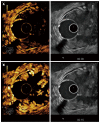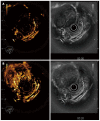Advances in endoscopic ultrasound imaging of colorectal diseases
- PMID: 26855535
- PMCID: PMC4724607
- DOI: 10.3748/wjg.v22.i5.1756
Advances in endoscopic ultrasound imaging of colorectal diseases
Abstract
The development of endoscopic ultrasound (EUS) has had a significant impact for patients with digestive diseases, enabling enhanced diagnostic and therapeutic procedures, with most of the available evidence focusing on upper gastrointestinal (GI) and pancreatico-biliary diseases. For the lower GI tract the main application of EUS has been in staging rectal cancer, as a complementary technique to other cross-sectional imaging methods. EUS can provide highly accurate in-depth assessments of tumour infiltration, performing best in the diagnosis of early rectal tumours. In the light of recent developments other EUS applications for colorectal diseases have been also envisaged and are currently under investigation, including beyond-rectum tumour staging by means of the newly developed forward-viewing radial array echoendoscope. Due to its high resolution, EUS might be also regarded as an ideal method for the evaluation of subepithelial lesions. Their differential diagnosis is possible by imaging the originating wall layer and the associated echostructure, and cytological and histological confirmation can be obtained through EUS-guided fine needle aspiration or trucut biopsy. However, reports on the use of EUS in colorectal subepithelial lesions are currently limited. EUS allows detailed examination of perirectal and perianal complications in Crohn's disease and, as a safe and less expensive investigation, can be used to monitor therapeutic response of fistulae, which seems to improve outcomes and reduce the need for additional surgery. Furthermore, EUS image enhancement techniques, such as the use of contrast agents or elastography, have recently been evaluated for colorectal indications as well. Possible applications of contrast enhancement include the assessment of tumour angiogenesis in colorectal cancer, the monitoring of disease activity in inflammatory bowel disease based on quantification of bowel wall vascularization, and differentiating between benign and malignant subepithelial tumours. Recent reports suggest that EUS elastography enables highly accurate discrimination of colorectal adenocarcinomas from adenomas, while inflammatory bowel disease phenotypes can be distinguished based on the strain ratio calculation. Among EUS-guided therapies, the drainage of abdominal and pelvic collections has been regarded as a safe and effective procedure to be used as an alternative for the transcutaneous route, while the placing of fiducial markers under EUS guidance for targeted radiotherapy in rectal cancer or the use of contrast microbubbles as drug-delivery vehicles represent experimental therapeutic applications that could greatly impact the forthcoming management of patients with colorectal diseases, pending on further investigations.
Keywords: Colorectal cancer; Colorectal submucosal tumours; Contrast-enhanced endoscopic ultrasound; Elastography; Endoscopic ultrasound; Endoscopic ultrasound-guided therapy; Inflammatory bowel disease.
Figures





Similar articles
-
Rectal Endoscopic Ultrasound in Clinical Practice.Curr Gastroenterol Rep. 2019 Apr 12;21(4):18. doi: 10.1007/s11894-019-0682-9. Curr Gastroenterol Rep. 2019. PMID: 30980194 Review.
-
Endoscopic ultrasound-guided fine-needle aspiration biopsy and trucut biopsy in gastroenterology - An overview.Best Pract Res Clin Gastroenterol. 2009;23(5):743-59. doi: 10.1016/j.bpg.2009.05.006. Best Pract Res Clin Gastroenterol. 2009. PMID: 19744637 Review.
-
Utility of an upper echoendoscope for endoscopic ultrasonography of malignant and benign conditions of the sigmoid/left colon and the rectum.Am J Gastroenterol. 2001 Dec;96(12):3318-22. doi: 10.1111/j.1572-0241.2001.05332.x. Am J Gastroenterol. 2001. PMID: 11774943
-
Pretherapeutic evaluation of patients with upper gastrointestinal tract cancer using endoscopic and laparoscopic ultrasonography.Dan Med J. 2012 Dec;59(12):B4568. Dan Med J. 2012. PMID: 23290296 Review.
-
Endoscopic ultrasound elastography: Current status and future perspectives.World J Gastroenterol. 2015 Dec 21;21(47):13212-24. doi: 10.3748/wjg.v21.i47.13212. World J Gastroenterol. 2015. PMID: 26715804 Free PMC article. Review.
Cited by
-
Assessing tumor angiogenesis in colorectal cancer by quantitative contrast-enhanced endoscopic ultrasound and molecular and immunohistochemical analysis.Endosc Ultrasound. 2018 May-Jun;7(3):175-183. doi: 10.4103/eus.eus_7_17. Endosc Ultrasound. 2018. PMID: 28685747 Free PMC article.
-
Endoscopic Ultrasound Elastography in the Assessment of Rectal Tumors: How Well Does It Work in Clinical Practice?Diagnostics (Basel). 2021 Jun 29;11(7):1180. doi: 10.3390/diagnostics11071180. Diagnostics (Basel). 2021. PMID: 34209811 Free PMC article.
-
Classification of contrast-enhanced ultrasonograms in rectal cancer according to tumor inhomogeneity using machine learning-based texture analysis.Transl Cancer Res. 2022 May;11(5):1053-1063. doi: 10.21037/tcr-21-2362. Transl Cancer Res. 2022. PMID: 35706817 Free PMC article.
-
EFSUMB Recommendations for Gastrointestinal Ultrasound Part 3: Endorectal, Endoanal and Perineal Ultrasound.Ultrasound Int Open. 2019 Jan;5(1):E34-E51. doi: 10.1055/a-0825-6708. Epub 2019 Feb 5. Ultrasound Int Open. 2019. PMID: 30729231 Free PMC article. Review.
-
EUS and EUS-guided FNA/core biopsies in the evaluation of subepithelial lesions of the lower gastrointestinal tract: 10-year experience.Endosc Ultrasound. 2020 Sep-Oct;9(5):329-336. doi: 10.4103/eus.eus_51_20. Endosc Ultrasound. 2020. PMID: 32913150 Free PMC article.
References
-
- Chong AK, Caddy GR, Desmond PV, Chen RY. Prospective study of the clinical impact of EUS. Gastrointest Endosc. 2005;62:399–405. - PubMed
-
- Fusaroli P, Saftoiu A, Mancino MG, Caletti G, Eloubeidi MA. Techniques of image enhancement in EUS (with videos) Gastrointest Endosc. 2011;74:645–655. - PubMed
-
- Cârţână ET, Pârvu D, Săftoiu A. Endoscopic ultrasound: current role and future perspectives in managing rectal cancer patients. J Gastrointestin Liver Dis. 2011;20:407–413. - PubMed
Publication types
MeSH terms
LinkOut - more resources
Full Text Sources
Other Literature Sources
Medical

